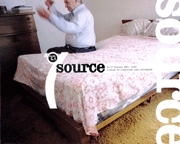Ireland of the Welcomes...
'Hide That Can', an exhibition of photography by Deirdre O'Callaghan was at the Gallery of Photography, Dublin
Review by Suzanne O'Shea
Issue 27 Summer 2001
View Contents ▸
"O'Callaghan is keen to ensure that she is not seen as someone who has exploited her subject; not some fashion photographer dirtying her fingers with a little urban reality" (Irish Times, March 1st).
Perhaps it's me. Perhaps I'm cynical and lacking in empathy, but I'm sceptical of fashion photographers trying to raise awareness of social issues. I am particularly sceptical of fashion photographers who have not pre-planned an exhibition, yet end up showcasing at Temple Bar with impending catalogue (forthcoming Westzone Autumn '01) and appropriate media coverage.
Ostensibly a cutting-edge, social realist visual commentary, this appears to me, to be a sanitised, presentist view of the Irish diaspora in Britain - the Camden Irish of Arlington House. Despite the exhibition documentation's claim that this work 'is a challenge to the nostalgia developing around emigration', it adds to it by presenting an overly sympathetic, idealistic view of the mostly unemployed, often alcoholic and rapidity ageing inhabitants of Arlington House, built in 1,905 to provide decent housing for working men. It was largely Irish labourers who, over the course of the century, made it their home away from home and developed, in common with many other Irish emigrant groups in Britain "an informal culture of mutual support". (Dr. Marcus Free, Arlington House and the Irish in Britain Exhibition Documentation).
In 1972, records Paul. Whitington, (Aer Lingus/Cara Magazine, March 2001,) there were 1,140 such men, many of them putting down a typical week working for several different contractors, so plentiful the work, so great the demand.0n it went, into the mid 1980's when the unthinkable happened - the work dried up and with it the money and the inevitable end of week drinking sessions. Unimaginably, almost two decades later, many of the men still live at Arlington House, and now, their portraits hang, courtesy of Deirdre O'Callaghan in a gallery of photography in Temple Bar, Dublin, in an Ireland few of them could possibly either relate to or recognise.
The potential historical value of the photographic process has long fascinated me. Think of Monet near Giverny, for example, for ever bearded, for ever rotund. Or the inscrutable complexities of the Bauhaus wives, preserved by the gifted Lucia Moholy. Here however, the immediacy of the photographic process, its aesthetic possibilities, are diluted into what appear to me to be a series of carefully choreographed tableaux - high resolution, slickly textured photographs which move me not at all. 0'CaLLaghan says that this is a personal project, a homage to men of her father's generation. She wants, through the medium of her lens, to relate the stories of these men to their Celtic tiger fed countrymen and women, kin, if you will, of Michael, Frank, Billy and Peter; of slouch-hatted 'John from Cork' and 'Michael, 40 cans' of the red battered face; of baggy-suited Michael Farrell and faded, wise man, Francis Hector McDonald, who invites them to 'baptise' his cup. In another, rather incongruous study, two 'bhoys', Michael and Paddy linger beneath a picture of a palm tree in the hallway, deep in a 'casual' conversation. A sentimental arrangement of daisies in a beer can says it all - artfulness over poignancy, sentiment over soul.
And as for documenting the worthy Aisling project, founded in 1994 by workers from both the London Irish centre and Arlington House with the aim of providing an annual Irish holiday for the 'veterans' and facilitating relocation, if required - what we get is 'six go down to the sea' in County Clare, all soft-focus silhouette and trouser Leg flapping gently in the welcoming Irish breeze. What we get is the aforementioned Francis Hector McDonald doing a Bull McCabe in yet another Irish Field. Again, it is Paul Whitington who describes the reality - the emotional, painful and often traumatic experience of the returning immigrant. For ever sister screaming with joy at the return of a long lost brother, there are many more paralysed by regret at the graves of long-dead family members, afraid to get out the Aisling van in their home towns. I am reminded of Pat McCabe's novel Carn. Josie Keenan, returning Irish emigrant, freshly Liberated from a sixteen year stint in the bars of Liverpool and Manchester, stands before her parent's grave and sees "her own death, a gunmetal face fixed on the sky".
Hide that Can takes no risks aesthetically - for example related subject matter has frequently been expertly and experimentally treated in the Sunday Times Magazine - and presents a sentimental view of a very complex issue. Unlike the documentation cited in this review, the exhibition challenges me neither emotionally nor intellectually. Of course it is important not to forget those marginalised by history, particularly those who marginalise themselves and perhaps for some who see the exhibition, the fact that these men are brought to Life, ever for a brief interlude, may be enough. For others, it will serve as a reminder that if indeed there is scope for a comprehensive photographic exhibition documenting the complexities of the Largest ethnic group in Britain, this most certainly isn't it.
Other articles mentioning Deirdre O'Callaghan:






